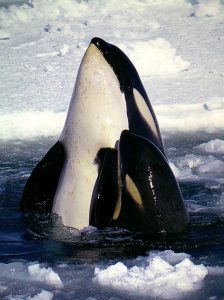
What is spyhopping? In this week’s Dolphin Pod News, we heard a short audio clip wherein Hayden Panettiere mentions a cetacean behavior known as spy hopping . Describing her encounter with Japanese hunters and a group of pilot whales trapped in the cove, Hayden said: “There was one point when they were literally spy-hopping, which is when they jump out of the water and stick their heads up out of the water and they can look around”. What exactly is spyhopping and why do whales and dolphins do it?
Well for once, the answer to this question is as obvious as it seems it should be. Whales and dolphins hold their heads out of the water in order to visually inspect the environment above the water line. Many species of whales and dolphins are known to engage in spy hopping. Perhaps the most prolific spy-hoppers are orca and humpback whales; two species who receive quite a bit of attention from the tourist industry. Spy hopping behavior consist of the cetacean holding itself vertically in the water and kicking with its tail fluke in order to hold its head above the water line. Some individuals are able to keep this up for minutes at a time. It is quite similar to treading water for a human, although likely somewhat more difficult for cetaceans because they are less buoyant in water than we are.
Spyhopping Orcas
[ms_youtube link=”https://www.youtube.com/watch?v=zFuUwYQGCq4″ width=”100%” height=”100%” mute=”no” autoplay=”no” loop=”no” controls=”yes” class=”dcp-embed-yt” id=””][/ms_youtube]
You may recall from an earlier episode of The Dolphin Pod that dolphins and whales have eyeballs that are specially designed for underwater vision. Whales and dolphins evolved from land animals many millions of years ago, and their eyeballs had to evolve in order to adjust to permanent underwater living. But the changes in their eyeballs were remarkable in that, despite their ability to see quite well underwater, both dolphins and whales have retained excellent vision in air. Although perhaps ‘retained’ is not the correct term; in order for a dolphin’s eyeball to have evolved the ability to see equally as well in water as in air, new anatomical structures were required. These include a rounded fish-eye like form to the eyeball together with a highly mobile lens that is capable of dramatically changing position. The end result of all this fancy evolution is that, when a dolphin or whale engages in spy hopping behavior, it is able to see almost as well as you or I can at the surface.
Scientists have observed that spyhopping occurs frequently when dolphins or whales interact with tourist boats. It is simply a case of that they wish to see what all the fuss is about at the surface, and the best way to do this is to hold your head out of the water.
Echolocation is entirely ineffective in air. The difference in density between air and water means that any echolocation directed at the surface will be completely useless – all of the sound waves will bounce off of the surface, making it impossible for a whale or dolphin to tell what is going on without sneaking a peak. Spyhopping is seen frequently around Vancouver Island in British Columbia – where groups of tourist in whale watching vessels flock to see the largest dolphin of all: the orca. The vast majority of objects and phenomena that a dolphin or whale needs to know about can be found under the water. But humans, in our strange surface-skimming boats, present a curious new object to whales and dolphins; an object that must be inspected both above and below the water’s surface to be fully appreciated.
But spyhopping is only one of the many cetacean behaviors that take place ‘at the surface’. Aside from breaking the surface to breath and spyhop, whales and dolphins are known to lunge out of the water, and to porpoise – a behavior where they arc out of the water but remain mostly horizontal while travelling at speed; presumably to reduce drag when in a hurry. They also engage in a variety of behaviors that fall under the umbrella of ‘breaching ’. Breaching can take many forms, from shallow side-flops, to high jumps many meters above the water’s surface. In the case of spinner dolphins or dusky dolphins, these breaches and jumps can be accompanied by crazy spins or other twists and turns, forming complex aerial displays. Scientist are still puzzled as to the meaning of the various forms of breaching. Different forms of breaching and jumping may be used as visual communicative signals, as means of orientation, as social signals associated with play, fighting or courtship, as a means of stunning fish, in order to create a loud sounds used in communication, or as a way to remove parasites. Spyhopping on the other hands appears to be a very simple behavior with an obvious goal; to see what’s going on .
Breaching Humpback Whale
[ms_youtube link=”https://www.youtube.com/watch?v=Fs7OsLvumhU” width=”100%” height=”100%” mute=”no” autoplay=”no” loop=”no” controls=”yes” class=”dcp-embed-yt” id=””][/ms_youtube]
[ms_audio style=”light” mp3=”https://www.dolphincommunicationproject.org/wp-content/uploads/2022/05/thedolphinpod2sciencespotlight.mp3″ ogg=”” wav=”” mute=”” loop=”” controls=”yes” class=”dcp-embed-mp3″ id=””]
